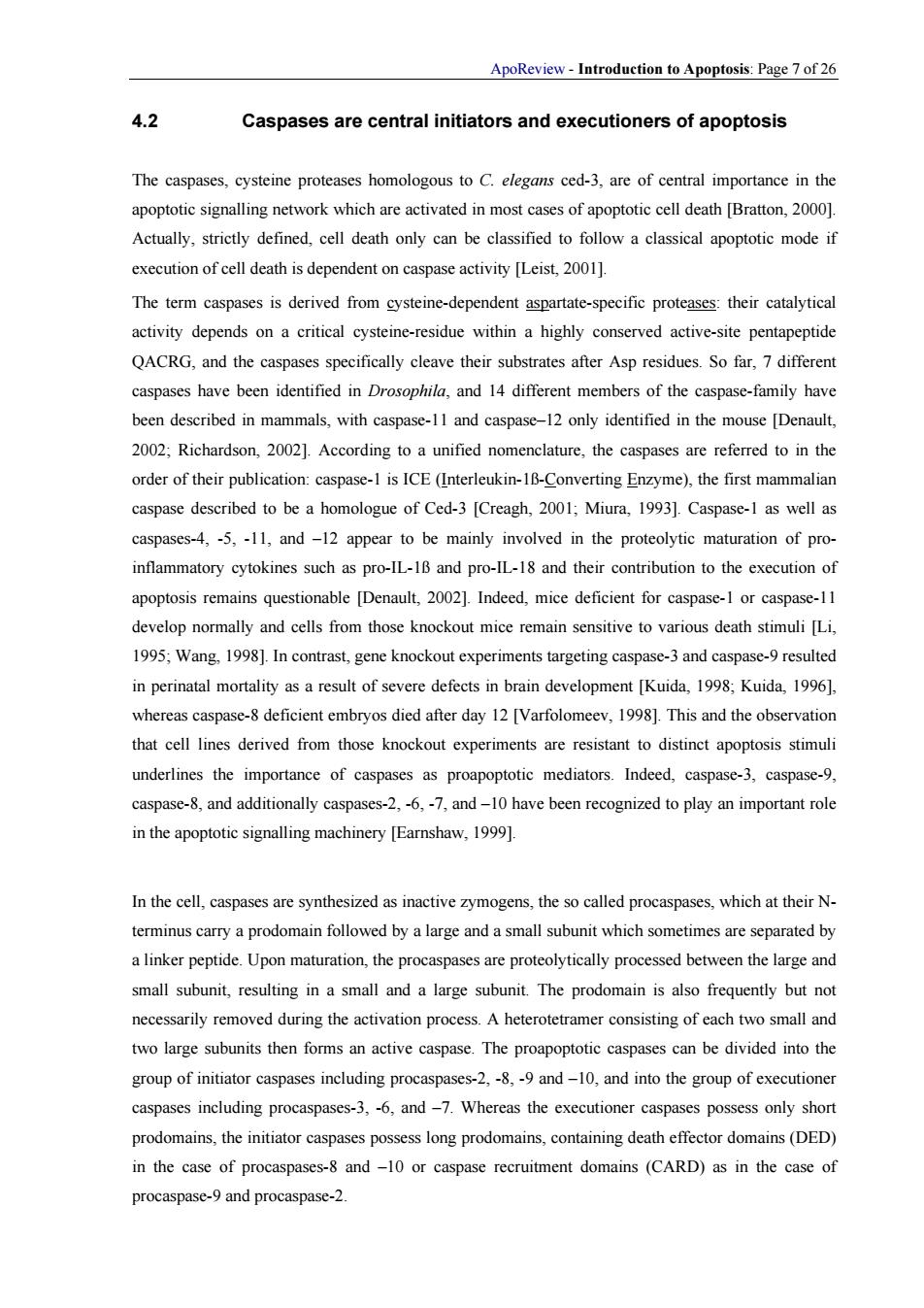正在加载图片...

ApoReview-Introduction to Apoptosis:Page 7 of 26 42 Caspases are central initiators and executioners of apoptosis The caspases,cysteine proteases homologous to C.elegans ced-3,are of central importance in the apoptotic signalling network which are activated in most cases of apoptotic cell death [Bratton,2000]. Actually,strictly defined,cell death only can be classified to follow a classical apoptotic mode if execution of cell death is dependent on caspase activity [Leist2001]. The term caspases is derived from ysteine-dependent aspartate-specific proteases their catalytical activity depends on a critical cysteine-residue within a highly conserved active-site pentapeptide QACRG,and the caspases specifically cleave their substrates after Asp residues.So far,7 different caspases have been identified in Drosophla,and 14 different members of the caspase-family have been described in mammals,with caspase-11 and caspase-12 only identified in the mouse [Denault, 202:Richardson,2002]According to a unified nomenclature,the caspases are referred to in the order of their publication:caspase-1 is ICE(Interleukin-1B-Converting Enzyme).the first mammalian caspase described to be a homologue of Ced-3 [Creagh,2001;Miura,1993].Caspase-1 as well as caspases-.,-11,and-12 appear to be mainly involved in the proteolytic maturation of pro inflammatory cytokines such as pro-IL-1B and pro-L-1and their contribution to the execution of apoptosis remains questionable [Denault,2002].Indeed,mice deficient for caspase-1 or caspase-11 develop normally and cells from those knockout mice remain sensitive to various death stimuli [L 1995;Wang.1998].In contrast,gene knockout experiments targeting caspase-3 and caspase-9 resulted in perinatal mortality as a result of severe defects in brain development [Kuida.99:Kuida.199] whereas caspase-deficient embryos died after day 12 [Varfolomeev,1]This and the observation that cell lines derived from those knockout experiments are resistant to distinct apoptosis stimuli underlines the importance of caspases as proapoptotic mediators.Indeed,caspase-3.caspase-9, caspase-and additionally caspases-27,and-10have been recognized to play an important rol in the apoptotic signalling machinery [Earnshaw,1999]. In the cell,caspases are synthesized as inactive zymogens,the so called procaspases,which at their N- terminus carry a prodomain followed by a large and a small subunit which sometimes are separated by a linker peptide.Upon maturation,the procaspases are processed between the large and small subunit,resulting in a small and a large subunit.The prodomain is also frequently but not necessarily removed during the activation process.A heterotetramer consisting of each two small and two large subunits then forms an active caspase.The proapoptotic caspases can be divided into the group of initiator caspases including procaspases-2.-9and-10,and into the group of executioner caspases including procaspases-3.-6.and-7.Whereas the executioner caspases possess only short prodomains,the initiator caspases possess long prodomains,containing death effector domains(DED) in the case of procaspases-8 and-10 or caspase recruitment domains (CARD)as in the case of procaspase-9 and procaspase-2.ApoReview - Introduction to Apoptosis: Page 7 of 26 4.2 Caspases are central initiators and executioners of apoptosis The caspases, cysteine proteases homologous to C. elegans ced-3, are of central importance in the apoptotic signalling network which are activated in most cases of apoptotic cell death [Bratton, 2000]. Actually, strictly defined, cell death only can be classified to follow a classical apoptotic mode if execution of cell death is dependent on caspase activity [Leist, 2001]. The term caspases is derived from cysteine-dependent aspartate-specific proteases: their catalytical activity depends on a critical cysteine-residue within a highly conserved active-site pentapeptide QACRG, and the caspases specifically cleave their substrates after Asp residues. So far, 7 different caspases have been identified in Drosophila, and 14 different members of the caspase-family have been described in mammals, with caspase-11 and caspase–12 only identified in the mouse [Denault, 2002; Richardson, 2002]. According to a unified nomenclature, the caspases are referred to in the order of their publication: caspase-1 is ICE (Interleukin-1ß-Converting Enzyme), the first mammalian caspase described to be a homologue of Ced-3 [Creagh, 2001; Miura, 1993]. Caspase-1 as well as caspases-4, -5, -11, and –12 appear to be mainly involved in the proteolytic maturation of proinflammatory cytokines such as pro-IL-1ß and pro-IL-18 and their contribution to the execution of apoptosis remains questionable [Denault, 2002]. Indeed, mice deficient for caspase-1 or caspase-11 develop normally and cells from those knockout mice remain sensitive to various death stimuli [Li, 1995; Wang, 1998]. In contrast, gene knockout experiments targeting caspase-3 and caspase-9 resulted in perinatal mortality as a result of severe defects in brain development [Kuida, 1998; Kuida, 1996], whereas caspase-8 deficient embryos died after day 12 [Varfolomeev, 1998]. This and the observation that cell lines derived from those knockout experiments are resistant to distinct apoptosis stimuli underlines the importance of caspases as proapoptotic mediators. Indeed, caspase-3, caspase-9, caspase-8, and additionally caspases-2, -6, -7, and –10 have been recognized to play an important role in the apoptotic signalling machinery [Earnshaw, 1999]. In the cell, caspases are synthesized as inactive zymogens, the so called procaspases, which at their Nterminus carry a prodomain followed by a large and a small subunit which sometimes are separated by a linker peptide. Upon maturation, the procaspases are proteolytically processed between the large and small subunit, resulting in a small and a large subunit. The prodomain is also frequently but not necessarily removed during the activation process. A heterotetramer consisting of each two small and two large subunits then forms an active caspase. The proapoptotic caspases can be divided into the group of initiator caspases including procaspases-2, -8, -9 and –10, and into the group of executioner caspases including procaspases-3, -6, and –7. Whereas the executioner caspases possess only short prodomains, the initiator caspases possess long prodomains, containing death effector domains (DED) in the case of procaspases-8 and –10 or caspase recruitment domains (CARD) as in the case of procaspase-9 and procaspase-2